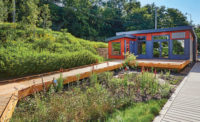The third edition, available this month, creates opportunities to reduce energy and water consumption by widening allowable temperature and humidity ranges. This increases the percentage of time that the compressor-free air-cooling mode can be used and even creates the opportunity for full-time free cooling, says Don Beaty, founder of DLB Associates Consulting Engineers, Ocean, N.J., and the first chair of ASHRAE's technical committee for mission critical facilities, technology spaces and electronic equipment.
The latest edition of the guidelines includes server failure rates as a function of temperature. "If someone has an expert-level knowledge of the guidelines, they can greatly reduce energy and water consumption while not compromising reliability," says Beaty.
Most data centers use either conventional chilled-water systems or outside-air-cooled systems with compressors or evaporative cooling for days the outside air is too hot. Chilled water systems are the most reliable, but use the most water. Both system types need to be sized for the worst-case design-day PUE, even though they may rarely use the capacity.
"All the systems perform OK in certain regions and under certain conditions but they all have trade-offs," says Skanska's Carnemark.
Designers looking for more-sustainable infrastructure have options. On the water side, they include greater use of air-cooling; use of recycled water for cooling-tower makeup and the incorporation more water-efficient liquid-cooling systems. Other strategies include capturing rainwater, treating gray water and specifying air-cooled, packaged chillers for small and medium-sized centers. Jacobs Engineering Group, Pasadena, is focusing on improved water chemistry and chemical-free water treatment, says Tom McDuffie, group vice president.
On the power side, many are increasing server utilization. An idle server consumes 75% of the power that a fully loaded machine does without providing tangible benefit, says Garr Di Salvo, an assistant principal in engineer Arup's New York City office.
On the facilities side, there is an effort to improve data center infrastructure management software, in an effort to optimize operations. Architect Gensler specifies "lights-out" data centers.
Modular servers and buildings and phased buildouts are becoming more popular as a way to right-size server capacity, thus minimizing stranded capital. TELUS, a Canadian telecommunications company, has just built a ">$65-million phased, modular facility in Rimouski, Quebec . The initial investment was 30% to 40% less than a built-out data center, says Lloyd Switzer, TELUS' senior vice president for network transformation.
To reduce dependency on the grid, some owners are installing renewable power sources, such as solar photovoltaics and wind. HP Labs is even researching a net-zero-energy-use data center. One goal is to reduce dependence on the power grid by 90% (see sidebar).
There net-zero skeptics. "It is not possible to have a truly net-zero facility," says Andy Baxter, a senior vice president with PageSutherlandPage, Austin. Data centers use energy to produce an energy-based IT infrastructure, and there are significant inefficiencies built into every part of the energy-transfer process, he says.
Generally, even renewable systems, other than hydro and nuclear power, do not pencil out. "Many data centers buy 'wind credits' to offset carbon footprints; however the true use of solar and wind [is not yet] a reliable or economical option for data centers," says Gary Orazio, president of full-service firm, Swanson Rink, Denver.
For each facility, the goal should be to make the building and its infrastructure as efficient as possible, then put in renewables and, finally, capture and reuse waste heat," says Otto Van Geet, a principal engineer with the National Renewable Energy Lab, Golden, Colo. NREL is building a high-performance-computing center for its Energy Systems Integration Facility. It has heat capture and reuse.
The need to shrink the carbon footprint of data centers is not going away. "Energy efficiency will continue to be a major focus of data center operations for a number of years, due to increasing demand for computing services, potential restrictions or limitations on resources such as water and power, and of course, cost," says Leonard A. Ruff, mission critical principal for architect Callison LLC, Seattle.
Scott Ganske, a construction executive for Mortenson Construction, Minneapolis, adds that the data center sector needs to "future-proof" facilities so owners and operators can adapt to new server densities and IT technologies. He agrees that sustainability, cost and time to market are other big issues.
"We expect these challenges will still be the key ones in five to 10 years," Ganske says. "These are journeys, not destinations."



Post a comment to this article
Report Abusive Comment